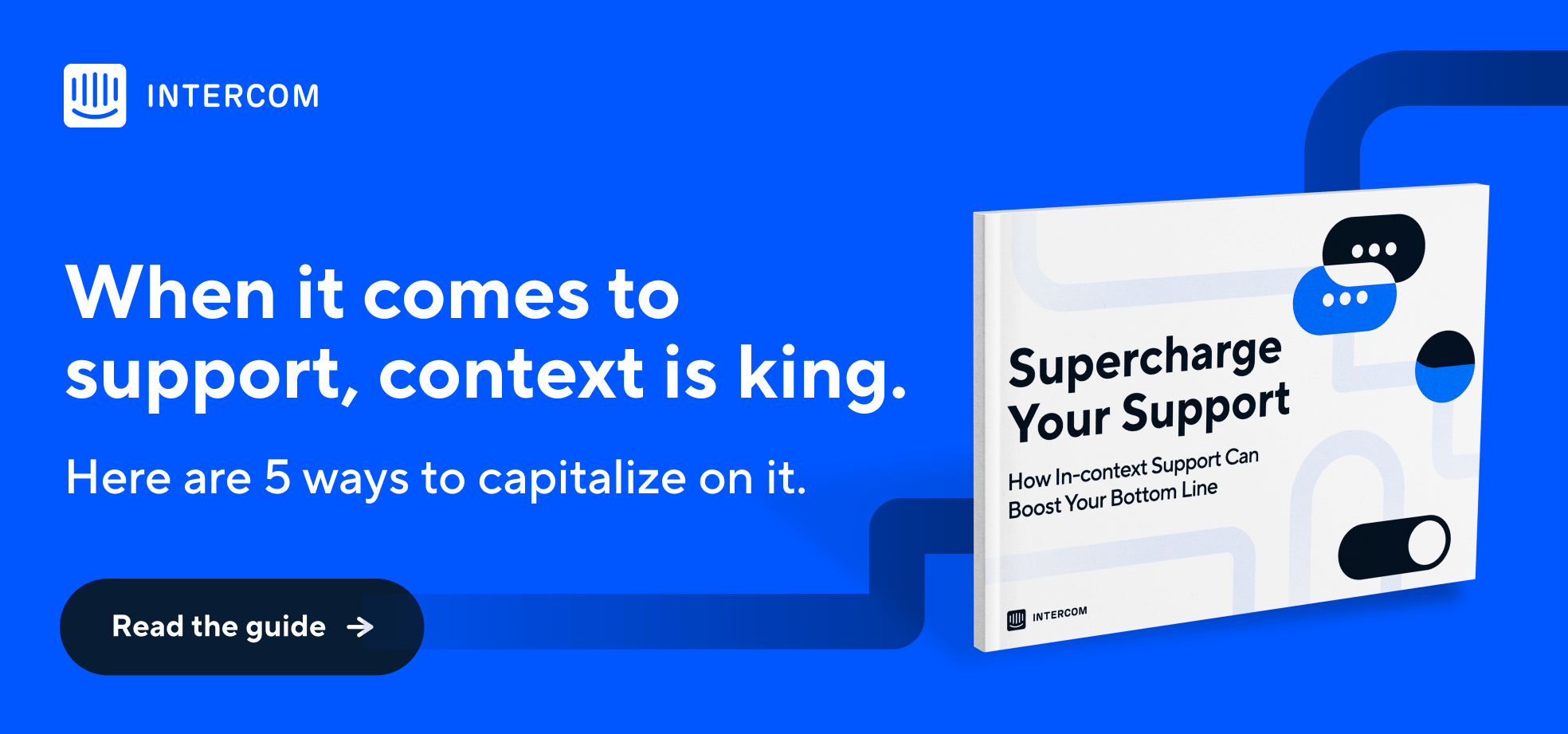
Key strategies to successfully scale your customer support team
Main illustration: Anastasia Tumanova
How do you scale great customer service without blowing the budget or killing the quality of the customer experience?
It’s an age-old question for anyone leading a customer support organization, the sort of challenge that requires continuous innovation as a company and its customer base expands.
With more than 25,000 customers and over 90 people on the Customer Support team, we’ve come a long way from the team of just nine when we first shared a blog post on using Intercom to support our customers. Our belief in a modern support model will never change, but we’ve spent a lot of time iterating on how best to scale our support department.
“There is more to scaling up than just machine learning and bots”
A key part of our conversational support strategy revolves around automation, but there is more to scaling up than just machine learning and bots. Here’s a look at how we have managed it and how you can too.
Your options for scaling customer support
When companies face the prospect of supporting rapidly increasing numbers of customers, they are faced with three fundamental choices:
1. Increase headcount to support customer growth
This option brings the benefit of maintaining a top notch level of service, but it also comes at a hefty financial and operational cost.
2. Degrade the support experience
This option relies on tactics like no-reply email addresses and endless wait-times, without taking a strategic approach to prioritization. It is cost effective in the short term but understandably unpopular with customers – and it is potentially detrimental in the long run due to its impact on customer satisfaction (CSAT) scores and employee retention.
3. Launch intelligent and cost-effective solutions that complement your customer experience
Clearly, the first two options have serious pitfalls. Luckily there is a third option. It includes using real-time automation with bots, strategies to drive customer self-service, and customer prioritization, alongside reasonably paced hiring.
This approach to scaling customer support, however, is tough to get right as it requires an excellent set of tools, intelligent experimentation and a fair amount of cross-functional partnership.
How to scale your customer support
In scaling up our own customer support team, we have aimed for that third option, an intelligent combination of approaches rather than throwing money at the problem or letting our standards slide. We’re using our own product solutions, of course, but I believe this balance of strategies can be adopted by any company facing the scaling challenge.
Here’s how you can scale customer support without ballooning your headcount or sacrificing your customer experience:
1. Embrace automation to strategically free up your team’s time
The foundation for modern, scalable customer support is automation. At Intercom, we look for ways to automate responses to common questions and routing customers to the right team for support, using customer service chatbots.
While it might seem like the use of bots is a less personal experience, in reality chatbots can powerfully augment a great customer support team and allow your team to focus on moments where a personal human touch really matters.
Using bots to automatically resolve questions
The primary chatbot in our toolbox is Resolution Bot, which automatically resolves customers’ most common questions in real time. We’ve found that on average, Resolution Bot instantly resolves 33% of your customers’ most common queries and improves customer response time by 44%.
Training our Resolution Bot was a simple process. From our experience, the upfront time investment that our team put into training the bot by way of answer curation and improvement more than paid itself back. The bot successfully reduced the repetitive questions our support agents were answering, freeing them to take on more technical support issues. Over time, we saw significant improvements in how Resolution Bot recognized similar questions from past conversations. Furthermore, resolution rates steadily climbed as we used the bot’s reporting to identify monitor which answers aren’t delivering and trained Resolution Bot to provide better answers.
Using bots to automatically route customers

We use another one of our automation tools, Custom Bots, to efficiently triage inbound conversation on our website. It ensures that lead questions flow to our Sales team and customer questions flow to our Support team. You can set it to guide customers through a set of structured questions so that you’re collecting pertinent details about their issues right away. Once team members pick up the conversation, they can get straight to work on resolving the issue, speeding up your resolution time.
As long as you focus automation strategies on solving the right problems, you can scale your support in a way that doesn’t put the customer experience – or your CSAT scores – at risk. They can even improve it!
2. Empower customers to find answers quickly with convenient self-service
Some customers don’t want to talk to you, so it is important to provide additional support channels such as an FAQ page or help center so they can find answers to their questions independently. But once collated, these answers and resources can also be suggested to customers who do reach out for assistance – for instance, Intercom’s Operator taskbot can suggest Articles in the Messenger, encouraging customers to find answers while they wait on a Support team reply. This approach has saved my team and our customers countless hours.

Modern support solutions should also easily integrate your help center articles with your team’s inbox. This kind of integration saves a tremendous amount of time since it gives your team instant access to the knowledge they need for their conversations with customers. They no longer have to open a separate window or tab just to search your knowledge base.
3. Prioritize the right customers
As your customer base and product suite grow, you will have an ever-widening range of queries and customer issues to resolve. This means that constantly refining how you prioritize those conversations is of fundamental importance. Intercom’s Inbox allows for smart team and customer segmentation through the use of multiple shared inboxes. They enable your team to easily prioritize conversations as well as quickly pass them to other teams for attention.
“By routing eligible new customers to a dedicated inbox and improving our first response times for them, we were able to drive 30% higher rate of trial conversions”
An example of where this worked well for us is the launch of our real time support strategy for new customers, a tactic that drove improved customer conversion and meaningful revenue wins for the business. By routing eligible new customers to a dedicated inbox and improving our first response times for them, we were able to drive 30% higher rate of trial conversions.
Making smart use of Intercom’s Inbox routing rules, internal notes and @mention features have also been great time savers for our team.
Continuous iteration is key to scaling customer support
Maximizing the benefits of automation, self-service and customer prioritization requires continuous iteration – after all, support looks a lot different at 10 people than it does at 100, and so on.
To ensure continuous iteration on our support model, we did the following:
- Constantly evaluate current processes and admin tools for inefficiencies
- Regularly experiment with a variety of new inboxes and response time strategies
- Periodically assess our support department productivity metrics and analytics
- Continually identify key areas that impact employee engagement
At a minimum, I’d recommend an annual evaluation of each of these areas to ensure you’re effectively scaling your Customer Support team. This process takes a village and is a great way to engage your top performers and management team in evolving your organization.
Scaling support while keeping your principles
Finally, it’s important not to lose sight of your principles in this process. One thing that hasn’t evolved in our path to 100 support team members and 25,000+ customers is our commitment to great customer and employee experience.
“Adopting tactics like automation shouldn’t come at the expense of your core values”
In this regard, our cultural tenets are our greatest tool. We are driven by a commitment to connect personally and with empathy, and we believe in treating the problem rather than the symptom. Adopting tactics like automation shouldn’t come at the expense of your core values. These modern approaches and your principles are not mutually exclusive.
Remember, if your business is growing, your Customer Support organization will scale whether or not you intend it to. However, how you manage this scaling process, and how it will impact your budget and employee engagement, is your choice. Choosing the right tools to help you effectively automate tasks, drive customer self-service, and make it easier to segment your team and customer base will be key to that process.







